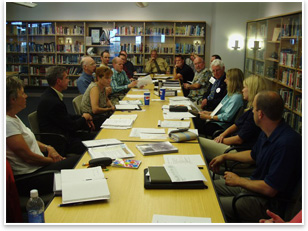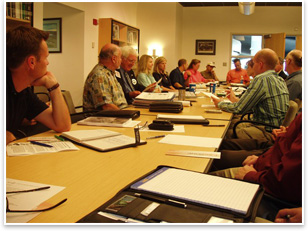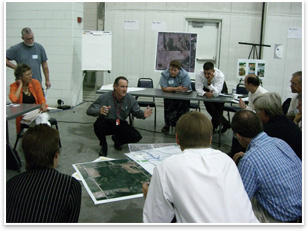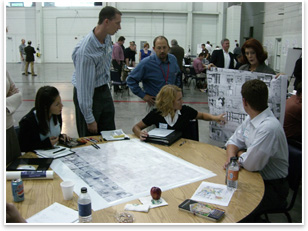
AIA 150 BLUEPRINT FOR AMERICA INITIATIVE by Russell Boniface
Summary: As part of the AIA 150 Blueprint for America Initiatives, AIA Nebraska has proposed “The Flatwater Metroplex: Envisioning Regional Design.” The Flatwater Metroplex is a 3,000-square-mile region encompassing 119 communities, 16 counties, and 60 miles around the metro areas of Omaha and Lincoln, Neb., and Council Bluffs, Iowa. The Flatwater Metroplex, however, is challenged by conflicting political jurisdictions that can’t agree on infrastructure growth patterns, economic goals, and planning. The challenge is heightened with the expectation that the region’s population will double in 40 years, underscoring the imperative to preserve the region’s rich agriculture and sustainability principles. The topography of the region known as the Flatwater Metroplex is agriculturally fertile, consisting of bluffs, tree-lined rivers and watersheds, prairies, and rolling hills. The region’s three major cities—Omaha, Lincoln, and Council Bluffs, Iowa—have a current population of 1.1 million, which is projected to exceed 2 million by the Year 2050. Despite political, economical, population, and planning obstacles, AIA Nebraska believes its proposed Flatwater Metroplex design can take advantage of the region’s natural assets, including two major rivers, to absorb growth and create a green environment. At the heart of the issue, however, are the growth and sustainability along the region’s I-80 corridor, a 50-mile, six-lane corridor, and how the corridor’s communities will preserve the landscape but still finance and manage its growing infrastructure and future transportation. Six charrettes held at the same time The six charrettes, held in the Strategic Air & Space Museum restoration hanger, focused on the region’s growth trends and sustainable principles. The charrettes focused on six prototype sites:
The I-80 Interstate Highway Corridor charrette was the largest of all six, with nearly 40 participants. Diverse stakeholders respond to AIA Nebraska’s call to action
“We had a wide spectrum of folks—architects, community officials, mayors, county and district representatives, owners of shopping centers, developers, eco-development organizations, the Nebraska zone commission, and University of Nebraska students who did a lot of recording. We were pleasantly surprised.” Adds Kay: "No one had a divergent agenda.” Infrastructure keeping pace with growth
AIA Nebraska, working with the Joslyn Castle Institute for Sustainable Communities and the Nebraska Innovation Zone Commission, prepared a final report, “Envisioning Regional Design: The Flatwater Metroplex Report.” (Click here.) ”We submitted the final report to state senators, who were quite impressed,” says Kay. Discussions ongoing AIA Nebraska members and regional stakeholders are still involved in discussions relating to various projects linking to AIA Nebraska’s Flatwater Metroplex development design plan. Kay concludes: “It was so controversial, but we probably will have to move fast. If anyone can make an impact it will be us.
|
||
Copyright 2008 The American Institute of Architects. All rights reserved. Home Page |
||
home
news headlines
practice
business
design
recent related
› AIA Government Advocacy and Advocacy Week
› Outstanding Programs, Individuals, Components Honored at Grassroots 2008
Read more about AIA’s Blueprint for America Initiatives.
For more information on AIA Nebraska’s Blueprint Initiative, go to “The Flatwater Metroplex: Envisioning Regional Design” on the AIA 150 Web site.
Read the full report on AIA Nebraska’s Web site.
To see what the AIA Regional and Urban Design Committee has to offer members, visit their page on AIA.org.

 How do you . . .
How do you . . .  AIA Nebraska worked with the Omaha-based Joslyn Castle Institute for Sustainable Communities to hold several public planning workshops that included architects; landscape architects; green building experts; developers; city, state, and local governments and agencies; non-governmental organizations; nonprofits; and community groups.
AIA Nebraska worked with the Omaha-based Joslyn Castle Institute for Sustainable Communities to hold several public planning workshops that included architects; landscape architects; green building experts; developers; city, state, and local governments and agencies; non-governmental organizations; nonprofits; and community groups.
 Recommendations; final report
Recommendations; final report